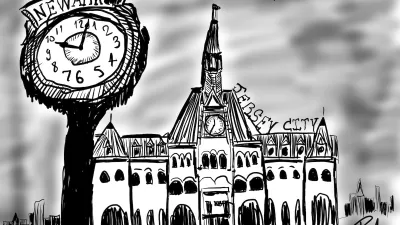Coney Island fights to preserve its history of sideshows and tilt-a-whirls as revitalization steps into the ring.
"For the past 25 years, Dick Zigun, the founder and artistic director of Coney Island USA, an arts organization, has found a way to capitalize on (...) the area's overlay of dissolution and current decay, and to elevate it to an aesthetic defining the area's art and entertainment. Back in the early '80s, Mr. Zigun created the Coney Island Circus Sideshow (complete with fire-eaters and contortionists) and launched the annual Mermaid Parade, both events that are hipster must-sees as well as good old-fashioned entertainment for the irony-free.
Mr. Zigun, a major figure in the revitalization of the area and a frequent informal spokesman for the amusement industry's various proprietors, was willing to see Coney Island's particular grittiness, cherished by some, obliterated in the name of a major redevelopment plan announced by the city in 2003.
"People find the seediness charming, and I realized that in terms of the way capitalism works and real estate works, you can't become enamored of the seediness," he said. "That's not what Coney Island was in its heyday."
Mr. Zigun was invoking the Coney Island of the early 20th century, when the amusement park sprawled across 70 acres, drawing both high-end and mass clientele to its spectacular state-of-the-art-rides and restaurants, its standing-room-only beach.
The possibilities of the city's strategic plan for Coney Island seduced Mr. Zigun, who signed on and joined the board of the Coney Island Development Corporation. For the future he saw grandeur, spectacle, phantasms. He saw, specifically, 15 acres of open-air amusement park, a significant expansion over the current space, and, in that acreage, the possibility for the world's greatest urban amusement park.
Last April, the city reduced the area dedicated to an open-air amusement park to nine acres. Last week, frustrated with the plan and its trajectory, Mr. Zigun resigned from the board."
FULL STORY: Visions for Coney Island Differ: Breathtaking Rides, or Shopping?

Montreal Mall to Become 6,000 Housing Units
Place Versailles will be transformed into a mixed-use complex over the next 25 years.

Planetizen Federal Action Tracker
A weekly monitor of how Trump’s orders and actions are impacting planners and planning in America.

DARTSpace Platform Streamlines Dallas TOD Application Process
The Dallas transit agency hopes a shorter permitting timeline will boost transit-oriented development around rail stations.

Without International Immigrants, the Rural US Population Would Be Falling 58%
Census data shows that population growth in rural areas is due in large part to international migrants.

Dead End: Nine Highways Ready for Retirement
The Freeways Without Futures report describes the nation’s most promising highway removal proposals.

Congressman Proposes Bill to Rename DC Metro “Trump Train”
The Make Autorail Great Again Act would withhold federal funding to the system until the Washington Metropolitan Area Transit Authority (WMATA), rebrands as the Washington Metropolitan Authority for Greater Access (WMAGA).
Urban Design for Planners 1: Software Tools
This six-course series explores essential urban design concepts using open source software and equips planners with the tools they need to participate fully in the urban design process.
Planning for Universal Design
Learn the tools for implementing Universal Design in planning regulations.
City of Mt Shasta
City of Camden Redevelopment Agency
City of Astoria
Transportation Research & Education Center (TREC) at Portland State University
City of Camden Redevelopment Agency
Municipality of Princeton (NJ)
Regional Transportation Commission of Southern Nevada





























